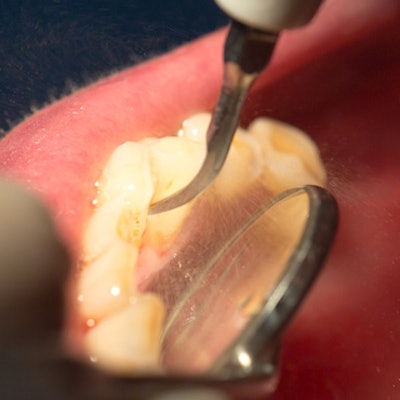
The current surgical model of caries management relies on symptomatic treatment via drilling and filling. However, the authors of a new review article in Dentistry Journal suggest practitioners should be refocusing their caries management using a medical model centered around prevention, timely intervention, and support of natural healing.
A paradigm shift from a surgical to a medical approach is better for achieving caries-free dentition and greater oral health-related quality of life, they explained (Dent J, April 1, 2019). The medical model for caries management includes such processes as controlling bacterial infection, changing the cariogenic environment, reducing caries risk levels, and remineralizing enamel and dentine
"According to the medical model, caries should be managed as a disease, rather than merely a collection of signs and symptoms," study co-author Chun Hung Chu, PhD, MDS, BDS, a clinical professor in operative dentistry at the University of Hong Kong in Pokfulam, told DrBicuspid.com. "The intention is to reduce the initiation and propagation of the disease and reverse tissue damage in order to preserve and promote dental health."
Getting a new attitude
Caries prevalence and incidence have remained unchanged in recent years, despite dental technology improvements, with untreated caries in permanent dentition the most prevalent disease among humans, the authors noted. They questioned whether current dental care is adequately honing in on the causes and risk factors of caries.
“According to the medical model, caries should be managed as a disease, rather than merely a collection of signs and symptoms.”
Increasingly, caries is being recognized as a disease involving demineralization of dental hard tissues, while the FDI World Dental Federation describes it as a noncommunicable and behavioral disease. While dentists have in the past spent much of their time using restorative treatments to address cavities, the authors pointed out that treating cavities, which are signs of disease, is different from treating the actual disease of caries.
The authors argued that in order to focus on eliminating caries disease, the medical model should take precedence over the surgical, even though both models have strengths and value. As they described it, the surgical model involves cutting and drilling teeth with cavities and filling them with artificial materials to restore form and function, addressing caries disease signs and symptoms but not the causes.
Meanwhile, they presented the medical model as a philosophy based on optimizing dental health by eliminating caries and focused on three areas in which the surgical model falls short:
- Preventing caries disease onset
- Arresting and halting current disease processes
- Reversing damage when possible
The medical model prevents caries from affecting healthy dental tissues through the application of fluoride and fissure sealants and the encouragement of dietary changes, the authors noted. While some people claim that the surgical model prevents caries by removing caries-prone fissures, caries can form on a newly cut surface and cutting away natural tooth substance weakens tooth structure, according to the authors.
When caries has already occurred, under the medical model, it should be treated through dietary counseling to limit frequent sugar consumption, promotion of oral hygiene to remove bulk bacterial load and cariogenic plaque, and the use of chemotherapeutic treatment to reduce caries-causing bacteria, they explained. Selective filling of cavities can be performed to create a cariostatic environment, they wrote.
However, only filling cavities, as under the surgical model, does not stop disease activity or progression. Without treatment of the cariogenic environment, caries can form where dental tissues are exposed, the authors noted.
Instead of removing demineralized enamel and dentine under the surgical model, remineralizing agents, such as topical fluorides, can be applied, and caries-affected tissues can heal if a noncariogenic environment is present.
For the medical model of caries management to be successful, the authors noted that it must include the following aspects:
- Control of bacterial infection
- Reduction of risk levels
- Remineralization of teeth
- Long-term follow-up
Caries is believed to result from the production of acid by certain bacteria that form in plaque biofilm when fermentable sugar is present, the authors explained. Chemotherapeutic medication, such as chlorhexidine, may help target bacterial biofilms in individuals with high levels of cariogenic bacteria.
Reducing caries risk can involve caries risk assessment followed by the development of a preventive plan. Risk factors can include caries experience, plaque level, and socioeconomic and lifestyle parameters.
Caries risk reduction can involve the following elements:
- Dietary analysis and recommendations to reduce sugar intake
- Plaque control through the promotion of good oral hygiene
- The use of chewing gum containing xylitol or other sugar substitutes to stimulate salivary flow
- The installation of pit-and-fissure sealants
- The use of fluoride for the remineralization of dental hard tissues
Greater sustainability
The medical model of caries management is ultimately more sustainable than the surgical model, allowing an aging worldwide population to retain more teeth for longer, the authors wrote.
"Both models have their strengths and value; however, when the focus is on elimination of the caries disease, it is apparent that the medical approach to the caries disease should prevail," they concluded.



















